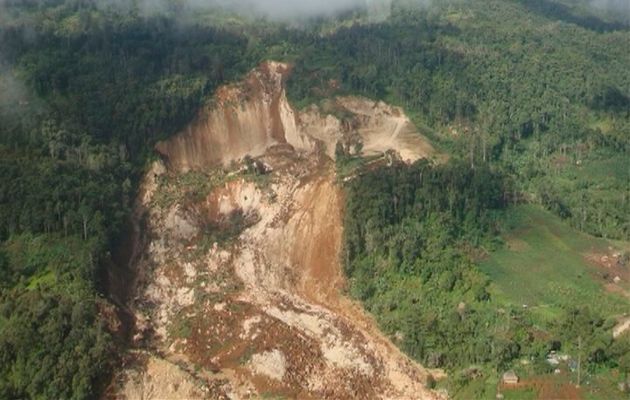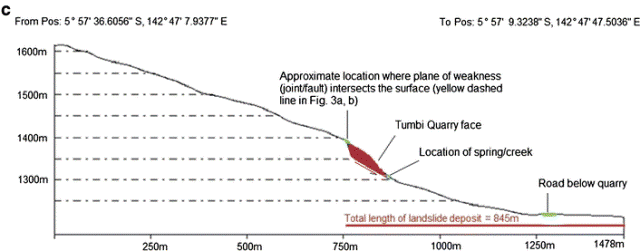4 November 2013
A new paper on the Tumbi Quarry landslide in Papua New Guinea
Posted by Dave Petley
![]()
Last year, and subsequently, I blogged on a number of occasions about the January 2012 Tumbi Quarry landslide in Papua New Guinea. In a nutshell, this very large landslide occurred in an aggregate quarry that had been used by contractors working for Esso Highlands (Exxon) in the construction of a pipeline. Everyone involved in the pipeline project denied that the quarry was in any way a factor in the landslide, even though this is by far the most likely cause. This image below shows the landslide, which killed at least 25 people and ruined the livelihoods of many more.
…
It seems to me that it is inconceivable to think that Esso / Exxon did not investigate this landslide themselves. It is interesting to note that they have not released the results of such an investigation.
Anyway, a paper (Robbins et al. 2013 – sadly not open access, and not in either the Reading University or the Met Office online repositories) has appeared in the journal Landslides which explores the Tumbi Quarry landslide. The paper has been co-authored by meteorologists and geologists, although as far as I can see none have a long publication track record in landslide research. The paper essentially examines the question of the trigger of the landslide, comparing the likelihood of a rainfall trigger versus the effects of a distant seismic event. However, in the introduction the paper also says that:
This paper gives a brief description of the landslide, with the main aims being: (1) to review the rainfall accumulations in the Tagali Valley prior to the landslide event, (2) review the likelihood that seismicity could have played a role in the failure and (3) provide an overview of the landslide in relation to the land use and activities at the quarry site.
In terms of the description of the landslide, the paper does a very reasonable job, although it does not really explore the possibility that the rear scarp of the landslide had an element of wedge failure (this would be an important consideration in stability modelling). Of course the meat of the paper is an investigation as to the role of rainfall triggering. The analysis here is comprehensive and interesting. The Tumbi Quarry landslide was a deep-seated failure, so one would expect that the landslide would respond to long term rainfall trends rather than short duration intense rainfall. The paper suggests that the months and days immediately prior to the failure did include the sort of rainfall events that have been associated with landslides in Papua New Guinea on previous occasions. However, the long term rainfall trend was below average, and the paper notes that:
The recurrence of below average monthly rainfall, particularly in November and December, and the timing of the slide at the start of the wet season, rather than the end, suggests that groundwater would have been close to the dry season low point or even lower, given the exceptionally low rainfall in August 2011. It seems unlikely therefore that groundwater played a significant role in the failure
The paper also looks at the role of seismicity in triggering the landslide – this is an interesting issue. They have examined the earthquake catalogue for events in Papua New Guinea in the 90 days prior to the landslide. The conclusion is, rightly, that seismicity played no role. On 14th December 2011 PNG was affected by an M=7.1 earthquake, but this occurred a month before the landslide at an epicentral distance of 478 km. The time delay and the distance both render it highly unlikely that this earthquake played a role. On the day of the landslide PNG was affected by a M=4.7 earthquake, but this occurred 446 km from the landslide site. Again, it is highly unlikely that this played any role. Thus, the seismic trigger hypothesis should be rejected.
A strange aspect of this paper is that the discussion of the role of quarry and land use changes in triggering the landslide is accorded just one paragraph, even though this is flagged early in the paper as being one of the core aims. The paragraph adds little to that already known; it highlights that the landslide occurred in the area that was being quarried, such that “[t]he additional extraction of material from the base of the steepest part of the slope may have weakened the integrity of the unit above…One factor which could be considered the most likely to have acted as a causal influence is the over-steepening of the existing steep slope by the extraction of additional material.” The report notes that an IESC report from November 2011 “suggests that the site was ‘benched and slopes have been stabilised such that the quarry is safe and could be reoccupied should this be required in the future’ (D’Appolonia S.p.A. 2011b). Such measures would have been put in place to increase the stability of the slope and quarry area following material extraction.” This may well be the case, but it is really important to note that benching would not increase the stability of a slope that was prone to the type of failure that actually occurred – indeed in some cases it could reduce the stability (if for example the toe of the slope was trimmed back to create the benches).
To me the most interesting aspect of this paper is the cross-section of the site, which is Fig. 3 in the paper:
..
The cross-section picks out that the landslide occurred on a steeply dipping slide surface with a near vertical release surface at the rear. It is highly likely that removal of material from the toe of such a setting would decrease the stability of the slope, and it is equally unlikely that benching the slope would increase stability. This is a quarry setting that would alarm any geologist with a knowledge of landslides.
I don’t want to be critical of this paper – the core aim is to analyse the rainfall conditions leading up to the landslide, and the paper does this really well. As such it is a useful contribution, as is the analysis of the likelihood of seismic triggering. However, in deep-seated landslides the actual trigger is often a sideshow – it is literally no more than the straw breaks that camel’s back. The key issue is how the slope became destabilised. The team have not undertaken the sort of fieldwork at the site that would allow a definitive analysis of the causes of the landslide, so understandably this is covered only lightly and with understandable caution. However, it is really important to recognise that this analysis does not let the operators of the quarry off the hook – indeed, the cross-section suggests that it is far more likely that the quarry was the cause of the problem. If the operators thought that stability of this site could be assured through benching the slope then they were sadly mistaken. Of course, it is also not possible to say that the quarry was responsible for the landslide. This is simply unknowable based upon the information to hand, and it could only be resolved with a proper investigation. Throughout the last two years I have avoided pinning the blame on any particular cause, and I would reiterate again that we simply do not know why this landslide happened. What I find unbelievable is that a slide that killed so many people has not been properly investigated. That is surely a scandal.
Reference
Joanne C. Robbins, Michael G. Petterson, Ken Mylne, & Joseph O. Espi (2013). Tumbi Landslide, Papua New Guinea: rainfall induced? Landslides, 10, 673-684 DOI: 10.1007/s10346-013-0422-4




 Dave Petley is the Vice-Chancellor of the University of Hull in the United Kingdom. His blog provides commentary and analysis of landslide events occurring worldwide, including the landslides themselves, latest research, and conferences and meetings.
Dave Petley is the Vice-Chancellor of the University of Hull in the United Kingdom. His blog provides commentary and analysis of landslide events occurring worldwide, including the landslides themselves, latest research, and conferences and meetings.